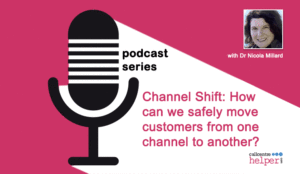Neil Titcomb of Odigo discusses how to to create personalized and channel-less experiences.
The diversification of communication channels presents opportunities and challenges to contact centre managers eager to provide coherent, channel-less customer experience over multiple channels and deliver a rewarding customer experience (CX) in increasingly competitive markets.
Connecting the right agent to the right customer on the right channel requires in-depth knowledge and insight, which can only be achieved by applying personalization strategies.
Omnichannel Support Should Transform Into Channel-Less Customer Experience
LinkedIn defines omnichannel as the integration of online and offline operations (e-commerce sites, online marketplaces, social media platforms and brick and mortar stores).
Essentially, customers should be able to conduct any aspect of their customer journey from any device or via any application without hindrance or limitations. Giving customers options and convenience not only improves customer satisfaction (CSAT) scores, but increases loyalty.
The financial benefits are a natural side effect, with Adobe reporting that companies with the strongest omnichannel customer engagement strategies enjoy a 10% year on year growth, a 10% increase in average order value and a 25% increase in close rates.
So what is the difference between omnichannel and channel-less CX? While the former provides uniform access and capabilities regardless of when, where and why, channel-less customer experience takes this process one step further and seamlessly links all interactions into one continuous conversation.
This means customers can enjoy a consistent brand experience irrespective of the channel, time and duration, or in the words of Martechadvisor: “The channel becomes incidental, – the experience central.”
Modern customers navigating hectic lifestyles expect brands to be flexible and timely in their ability to react. Thus, an email could lead to a text message and continue to a phone call before culminating in a face-to-face encounter.
Modern lifestyles require channel-less customer experience that prioritizes convenience and personalization.
A Diversification of Channels Across all Generations
The emergence of new channels has impacted the habits of all consumers. According to Microsoft, 31% of UK customers use 1-2 channels, 58% use 3-5 and 10% use over 6 channels when seeking customer service.
Though applying demographics to these results is important, as 18-34-year-olds are far more likely to engage in a variety of channels than the over 55-year-olds. What transcends the perspectives of Generation Z to baby boomers is the demand to be treated well.
Beyond the expectation that companies should offer rewarding customer service, customers understand that elevated levels of service come with added costs, but do not seem to mind this additional financial burden. Indeed, Capgemini reports that 81% of consumers are willing to increase their spend with an organisation in return for a better experience.
The digital transformation happening across all sectors has made self-service through AI-driven assistance more and more common.
The daily use of voice assistants in the UK has increased significantly over the last 12 months, according to MobileMarketing, with seven out of 10 consumers using their voice-controlled device on a daily basis and 93% at least once a week.
Channel-Less Customer Experience Achieved Through Personalization
Upgrading infrastructure and implementing cutting-edge, digital solutions is only part of the battle contact centre managers need to wage. Effectively creating real customer loyalty demands personalized care and support during every interaction.
This means operationalizing data and insights like never before, which can put a strain on any organization. The good news? Cutting-edge solutions are now able to offer the required support to achieve channel-less customer experience.
Advances in natural language processing (NLP) and machine learning (ML) have empowered conversational agents (chatbots and voicebots) with unprecedented levels of comprehension and communication, making personalization all the easier to achieve.
Beyond simply performing basic functions vis-à-vis customer-related tasks, conversational AI tools can perform sentiment analysis on text and recordings, thereby understanding the rising, falling and shifting tones of voice that reveal customers’ moods.
Conveying this information to agents will help them understand the best approach in dealing with customers’ requests and assist in recommending next best actions.
Along with real-time support in analysing up to the minute data, AI-based software embedded in agents’ consoles performs rapid analysis needed to be kept up to speed on a customer’s journey.
Are they in a buying cycle? How long have they been a customer? Should they be offered an upgrade? The unique particularities of every customer should be understood, appreciated and catered for.
Take for example three generations of the same family, who despite different preferences, all expect a convenient, channel-less customer experience.
Customer A, a middle-aged civil servant, is a long-standing customer whose demanding work schedule means she has a small window to place a phone call to resolve her issue during her lunchtime.
Her son, customer B, is a new joiner who prefers to communicate through apps and social media and only makes a phone call as a last resort. His grandmother, customer C, has never visited the brand’s website and finds mobile options confusing and risky.
As she is a pensioner and has more free time, she enjoys taking a stroll to the brick and mortar premises to sit down with someone who she expects will calmly walk her through any necessary operations.

Neil Titcomb
These customers’ journeys are drastically different and thus different strategies must be deployed to satisfy them. Before any CX plan can be put into action, the relevant information on each customer should be leveraged to understand who they are, what they want and how they want it done.
Applying personalization tactics to customer interactions is the best way to guarantee enriched customer service and achieve smooth channel-less customer experiences.
Meeting customers’ expectations can be daunting, but the possibilities of forming deep bonds and elevating a brand’s reputation have never been greater.
Author: Guest Author
Published On: 24th Nov 2020 - Last modified: 12th Jun 2024
Read more about - Guest Blogs, Neil Titcomb, Odigo















